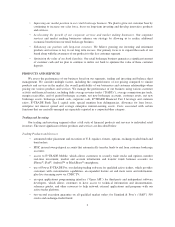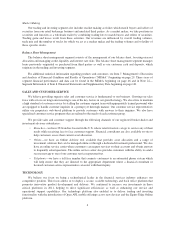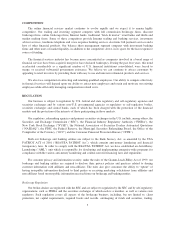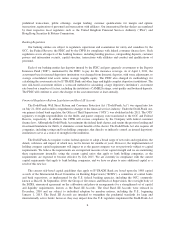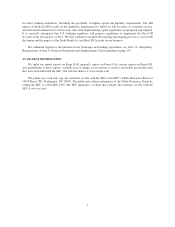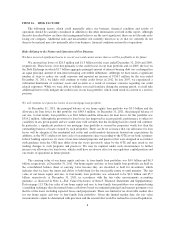eTrade 2011 Annual Report Download - page 15
Download and view the complete annual report
Please find page 15 of the 2011 eTrade annual report below. You can navigate through the pages in the report by either clicking on the pages listed below, or by using the keyword search tool below to find specific information within the annual report.increase dependence on more active trading customers who receive more favorable pricing based on their trade
volume. A decrease in trading activity or securities prices would also typically be expected to result in a decrease
in margin borrowing, which would reduce the revenue that we generate from interest charged on margin
borrowing.
We rely heavily on technology, and technology can be subject to interruption and instability.
We rely on technology, particularly the Internet, to conduct much of our activity. Our technology operations
are vulnerable to disruptions from human error, natural disasters, power loss, computer viruses, spam attacks,
unauthorized access and other similar events. Disruptions to or instability of our technology or external
technology that allows our customers to use our products and services could harm our business and our
reputation. In addition, technology systems, whether they be our own proprietary systems or the systems of third
parties on whom we rely to conduct portions of our operations, are potentially vulnerable to security breaches
and unauthorized usage. An actual or perceived breach of the security of our technology could harm our business
and our reputation.
Vulnerability of our customers’ computers and mobile devices could lead to significant losses related to identity
theft or other fraud and harm our reputation and financial performance.
Because our business model relies heavily on our customers’ use of their own personal computers, mobile
devices and the Internet, our business and reputation could be harmed by security breaches of our customers and
third parties. Computer viruses and other attacks on our customers’ personal computer systems and mobile
devices could create losses for our customers even without any breach in the security of our systems, and could
thereby harm our business and our reputation. As part of our E*TRADE Complete Protection Guarantee, we
reimburse our customers for losses caused by a breach of security of the customers’ own personal systems. Such
reimbursements could have a material impact on our financial performance.
We rely on third party service providers to perform certain functions.
We rely on third party service providers for certain technology, processing, servicing and support functions.
These third party service providers are also subject to operational and technology vulnerabilities, which may
impact our business. An interruption in or the cessation of service by any third party service provider and our
inability to make alternative arrangements in a timely manner could have a material impact on our business and
financial performance.
Downturns in the securities markets increase the credit risk associated with margin lending or securities loaned
transactions.
We permit certain customers to purchase securities on margin. A downturn in securities markets may impact
the value of collateral held in connection with margin receivables and may reduce its value below the amount
borrowed, potentially creating collections issues with our margin receivables. In addition, we frequently borrow
securities from and lend securities to other broker-dealers. Under regulatory guidelines, when we borrow or lend
securities, we must simultaneously disburse or receive cash deposits. A sharp change in security market values
may result in losses if counterparties to the borrowing and lending transactions fail to honor their commitments.
We may be unsuccessful in managing the effects of changes in interest rates and the enterprise interest-earning
assets in our portfolio.
Net operating interest income is an important source of our revenue. Our results of operations depend, in
part, on our level of net operating interest income and our effective management of the impact of changing
interest rates and varying asset and liability maturities. Our ability to manage interest rate risk could impact our
financial condition. We use derivatives to help manage interest rate risk. However, the derivatives we utilize may
not be completely effective at managing this risk and changes in market interest rates and the yield curve could
12


